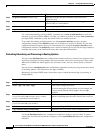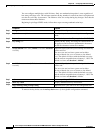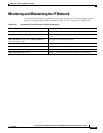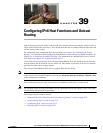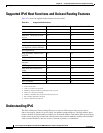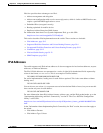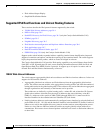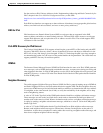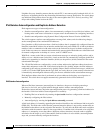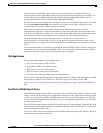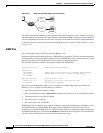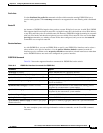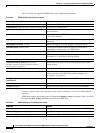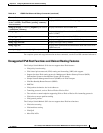
39-4
Cisco Catalyst Switch Module 3110 and 3012 for IBM BladeCenter Software Configuration Guide
OL-12189-01
Chapter 39 Configuring IPv6 Host Functions and Unicast Routing
Understanding IPv6
• IPv6 Address Output Display
• Simplified IPv6 Packet Header
Supported IPv6 Host Functions and Unicast Routing Features
These sections describe the IPv6 protocol features supported by the switch:
• 128-Bit Wide Unicast Addresses, page 39-4
• DNS for IPv6, page 39-5
• Path MTU Discovery for IPv6 Unicast, page 39-5 (only the Catalyst Switch Module 3110)
• ICMPv6, page 39-5
• Neighbor Discovery, page 39-5
• IPv6 Stateless Autoconfiguration and Duplicate Address Detection, page 39-6
• IPv6 Applications, page 39-7
• Dual IPv4 and IPv6 Protocol Stacks, page 39-7
• EIGRP IPv6, page 39-8 (only the Catalyst Switch Module 3110)
Support on the switch includes expanded address capability, header format simplification, improved
support of extensions and options, and hardware parsing of the extension header. The switch supports
hop-by-hop extension header packets, which are routed or bridged in software.
The Catalyst Switch Module 3110 provides IPv6 routing capability over native Ethernet Inter-Switch
Link (ISL) or 802.1Q trunk ports for static routes, Routing Information Protocol (RIP) for IPv6, and
Open Shortest Path First (OSPF) Version 3 protocol. It supports up to 16 equal-cost routes and can
forward IPv4 and IPv6 frames simultaneously at line rate.
128-Bit Wide Unicast Addresses
The switch supports aggregatable global unicast addresses and link-local unicast addresses. It does not
support site-local unicast addresses.
• Aggregatable global unicast addresses are IPv6 addresses from the aggregatable global unicast
prefix. The address structure enables strict aggregation of routing prefixes and limits the number of
routing table entries in the global routing table. These addresses are used on links that are aggregated
through organizations and eventually to the Internet service provider.
These addresses are defined by a global routing prefix, a subnet ID, and an interface ID. Current
global unicast address allocation uses the range of addresses that start with binary value 001
(2000::/3). Addresses with a prefix of 2000::/3(001) through E000::/3(111) must have 64-bit
interface identifiers in the extended universal identifier (EUI)-64 format.
• Link local unicast addresses can be automatically configured on any interface by using the link-local
prefix FE80::/10(1111 1110 10) and the interface identifier in the modified EUI format. Link-local
addresses are used in the neighbor discovery protocol and the stateless autoconfiguration process.
Nodes on a local link use link-local addresses and do not require globally unique addresses to
communicate. IPv6 routers do not forward packets with link-local source or destination addresses
to other links.



